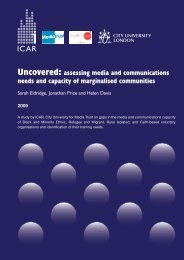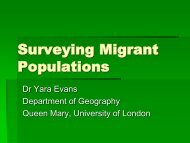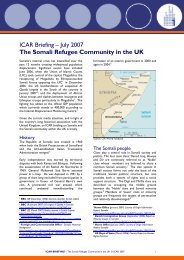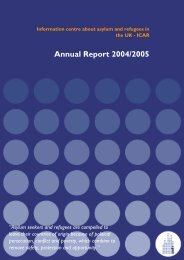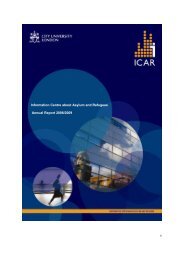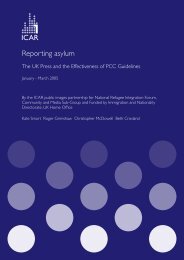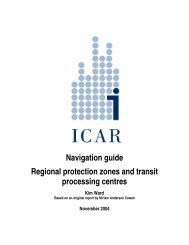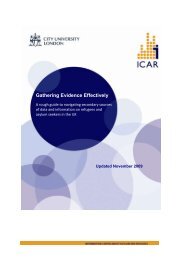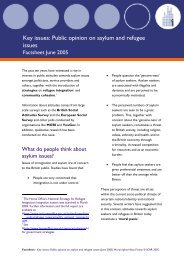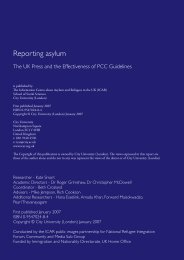The Somali community in the UK: What we know and how we ... - ICAR
The Somali community in the UK: What we know and how we ... - ICAR
The Somali community in the UK: What we know and how we ... - ICAR
Create successful ePaper yourself
Turn your PDF publications into a flip-book with our unique Google optimized e-Paper software.
<strong>The</strong>se men tended to form a separate <strong>community</strong>.<br />
This was partly because of <strong>the</strong>ir long absences<br />
at sea, whilst racism played its part. But it was<br />
also related to <strong>the</strong>ir ultimate goals. Despite <strong>the</strong>ir<br />
long sojourn <strong>in</strong> <strong>the</strong> <strong>UK</strong>, <strong>the</strong>ir sights <strong>we</strong>re still set<br />
on <strong>Somali</strong>a, with dreams of home - hopes still<br />
cherished by <strong>the</strong> older generation <strong>in</strong> <strong>the</strong> <strong>UK</strong>. 23<br />
Some would periodically travel back to visit<br />
<strong>the</strong>ir families, <strong>and</strong> also started <strong>the</strong> tradition of<br />
remittances, send<strong>in</strong>g back money to support <strong>the</strong>ir<br />
extended family <strong>and</strong> to build houses for <strong>the</strong>ir<br />
return. 24 But <strong>the</strong>n, as now, hope of return <strong>and</strong><br />
reality are different matters. As one woman, who<br />
arrived <strong>in</strong> <strong>the</strong> late 1980s, commented:<br />
<strong>The</strong>re was a time when most <strong>Somali</strong>s would go<br />
elsewhere <strong>in</strong> <strong>the</strong> world, not Engl<strong>and</strong>. People who<br />
came here never returned <strong>and</strong> <strong>the</strong>ir families<br />
back home used to talk about <strong>the</strong>m as if <strong>the</strong>y<br />
<strong>we</strong>re dead. In some cases, <strong>the</strong> wives left beh<strong>in</strong>d<br />
remarried. 25<br />
<strong>The</strong> second stage of this early settlement began<br />
at <strong>the</strong> end of <strong>the</strong> 1950s. <strong>The</strong> dem<strong>and</strong> for seamen<br />
was fall<strong>in</strong>g, but <strong>the</strong> economic boom was creat<strong>in</strong>g<br />
opportunities for employment <strong>in</strong> <strong>in</strong>dustry. <strong>Somali</strong><br />
communities began to emerge <strong>in</strong> Sheffield <strong>and</strong><br />
Manchester, <strong>and</strong> this less transitory way of life<br />
encouraged men to br<strong>in</strong>g <strong>the</strong>ir wives to <strong>the</strong> <strong>UK</strong>.<br />
It was dur<strong>in</strong>g this time that <strong>the</strong> present <strong>Somali</strong><br />
<strong>community</strong>, chiefly from <strong>the</strong> Isaaq clan family<br />
<strong>and</strong> Darood subclans from <strong>the</strong> north, became<br />
established <strong>in</strong> what is now To<strong>we</strong>r Hamlets,<br />
especially <strong>in</strong> Bow, Wapp<strong>in</strong>g, <strong>and</strong> Poplar 26 In this<br />
period numbers <strong>we</strong>re still small - estimates by<br />
old seamen range from a few hundred to over a<br />
thous<strong>and</strong>. But <strong>the</strong> fortunes of seafar<strong>in</strong>g settlements<br />
<strong>we</strong>re to wane. <strong>The</strong> merchant navy was decl<strong>in</strong><strong>in</strong>g<br />
dur<strong>in</strong>g <strong>the</strong> 1970s, <strong>and</strong> when it rega<strong>in</strong>ed strength<br />
<strong>in</strong> <strong>the</strong> next decade, <strong>Somali</strong>s <strong>we</strong>re excluded. <strong>The</strong><br />
economic recession threw more unskilled or semiskilled<br />
<strong>Somali</strong>s out of work, sett<strong>in</strong>g <strong>the</strong> pattern<br />
for unemployment <strong>and</strong> dependence on state<br />
benefits that still characterise <strong>the</strong> older <strong>Somali</strong><br />
communities.<br />
<strong>The</strong> next phase <strong>in</strong> <strong>Somali</strong> settlement was not of<br />
dependents or labour migrants, but of refugees.<br />
This exodus ga<strong>the</strong>red pace dur<strong>in</strong>g <strong>the</strong> 1980s,<br />
with <strong>the</strong> degeneration of <strong>the</strong> Barre regime <strong>and</strong><br />
escalat<strong>in</strong>g violence, culm<strong>in</strong>at<strong>in</strong>g <strong>in</strong> <strong>the</strong> 1988<br />
decimation of <strong>the</strong> north. Nor<strong>the</strong>rners fled. Some<br />
<strong>we</strong>nt close to home - Kenya, Saudi Arabia, <strong>and</strong><br />
<strong>the</strong> Gulf Emirates. <strong>The</strong>re <strong>the</strong>y could jo<strong>in</strong> <strong>Somali</strong>s<br />
already settled <strong>in</strong> <strong>the</strong> Gulf 27 - <strong>Somali</strong> women’s<br />
life stories often mention liv<strong>in</strong>g <strong>and</strong> work<strong>in</strong>g <strong>in</strong><br />
Aden whilst <strong>the</strong>ir husb<strong>and</strong>s or fa<strong>the</strong>rs <strong>we</strong>re at sea.<br />
O<strong>the</strong>rs sought asylum <strong>in</strong> <strong>the</strong> United States <strong>and</strong><br />
Europe - Germany, Norway, S<strong>we</strong>den, <strong>and</strong> also <strong>the</strong><br />
<strong>UK</strong>, where <strong>the</strong>y made for <strong>the</strong> areas where <strong>the</strong>ir<br />
families or co-clan members <strong>we</strong>re liv<strong>in</strong>g. This wave<br />
of <strong>Somali</strong> asylum seekers laid <strong>the</strong> foundations of<br />
<strong>the</strong> present pattern of settlement. After Barre’s fall<br />
<strong>in</strong> 1991, <strong>the</strong> cont<strong>in</strong>ued violence <strong>in</strong> <strong>the</strong> south drove<br />
many more out of <strong>Somali</strong>a <strong>in</strong> a second wave of <strong>the</strong><br />
contemporary migration.<br />
Some of those who fled to <strong>the</strong> <strong>UK</strong> dur<strong>in</strong>g <strong>the</strong><br />
post civil war period of <strong>the</strong> late 1980s <strong>and</strong> 1990s<br />
<strong>we</strong>re men, but <strong>the</strong> great <strong>in</strong>crease <strong>in</strong> <strong>the</strong> <strong>Somali</strong><br />
population <strong>in</strong> <strong>the</strong> <strong>UK</strong> was made up of women <strong>and</strong><br />
children. Some came to jo<strong>in</strong> <strong>the</strong>ir husb<strong>and</strong>s, but<br />
a great many <strong>we</strong>re s<strong>in</strong>gle women with children<br />
- <strong>the</strong>ir men had ei<strong>the</strong>r been killed or had stayed <strong>in</strong><br />
<strong>Somali</strong>a to fight. This exodus from <strong>Somali</strong>a meant<br />
that <strong>the</strong> overall character of <strong>Somali</strong> settlement<br />
<strong>in</strong> <strong>the</strong> <strong>UK</strong> changed from one of s<strong>in</strong>gle seamen to<br />
that of refugee communities, with at least as many<br />
women as men <strong>and</strong> a high proportion of children<br />
<strong>and</strong> young people.<br />
In more recent years, a large proportion of <strong>Somali</strong>s<br />
seek<strong>in</strong>g entry to <strong>the</strong> <strong>UK</strong> have come from countries<br />
o<strong>the</strong>r than <strong>Somali</strong>a. <strong>The</strong> diaspora now extends<br />
19. See Little (1948); Banton (1955); Coll<strong>in</strong>s (1957).<br />
20. Adan, Sulaika et al, 1987/8: 30.<br />
21. Green, Marianne, 2001: 17.<br />
22. Bullivant, M. et al (1995).<br />
23. Summerfield, 1996: 86.<br />
24. Remittances form an <strong>in</strong>creas<strong>in</strong>gly significant aspect of <strong>the</strong> diaspora<br />
process. See Omer, A. (2003), A report on support<strong>in</strong>g systems <strong>and</strong><br />
procedures for <strong>the</strong> effective regulation <strong>and</strong> monitor<strong>in</strong>g of <strong>Somali</strong><br />
remittance companies (hawala), UNDP; Gundel, J. (2002), <strong>The</strong><br />
migration-development nexus: <strong>Somali</strong>a case study, Copenhagen:<br />
Centre for Development Research; Sorensen et al (2002), <strong>The</strong> migrationdevelopment<br />
nexus: Evidence <strong>and</strong> policy options, Copenhagen:<br />
Centre for Development Research.<br />
25. Hassan, L., 2000: 81.<br />
26. El Solh, 1991: 540-41.<br />
27. E.g. Adan, S. et al, 1997/8: 9-11, 16.<br />
<strong>The</strong> <strong>Somali</strong> <strong>community</strong> <strong>in</strong> <strong>the</strong> <strong>UK</strong><br />
23





